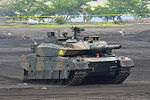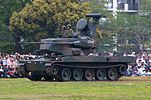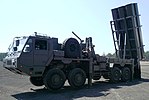Japanese State Army
| Japanese State Army | |
|---|---|
| 日本国陸軍 | |
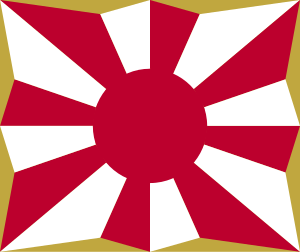 Flag of the Japanese State Army and Armed Forces | |
| Founded | 3 May 1952 |
| Country |
|
| Type | Army |
| Role | Land warfare |
| Size | 200,000 active personnel |
| Part of |
|
| Garrison/HQ | Ichigaya, Shinjuku, Tokyo, Japan |
| Red, White and Gold | |
| March |
Review March (分列行進曲) |
| Website | http://www.mod.go.jp/af |
| Commanders | |
| Prime Minister of Japan |
|
| Minister of Defense |
|
| Chief of Staff, Joint Staff |
|
| Chief of Staff, Ground Staff |
|
| Insignia | |
| Emblem | File:Japan Ground Self Defense Force Emblem JGSDF.png |
The Japanese State Army (日本国陸軍, Nippon-koku Rikugun), also referred to as the Japanese Army, is the land warfare branch of the Japanese State Armed Forces. Created on 3 May 1952, it is the largest of the three services branches.
The Japanese State Army is primarily tasked with defending the Japanese home islands from any potential foreign military invasion, and Japan has not participated in any military interventions itself since the end of the Great War. New military guidelines, announced in December 2000, direct the Japanese Armed Forces away from their Cold War focus on the China to a new focus on North Vietnam. This remained in effect until the 2019 National Security Strategy issued by the Office of the Prime Minister of Japan changed military doctrine to return the focus on China as the main potential military adversary of Japan, due to the annexation of Rehe Province by the Republic of China, the Senkaku Islands dispute, and the territorial disputes in the South China Sea. In 2021, a plan to expand the Japanese Army was approved that will be the largest increase in the size of the Army since the Great War.
The Japanese Army operates under the command of the chief of the ground staff, based in the city of Ichigaya, Shinjuku, Tokyo. The present chief of staff is General Kazunari Serizawa. The army numbered around 200,000 soldiers in 2010, and in 2021 the government announced a plan to increase the number of active troops to 300,000 by 2028 due to the increased tensions in the Indo-Pacific.
History
See also: Military history of Japan and Imperial Japanese Army
20th Century
Following the conclusion of the Pacific War in 1938 and the acceptance of the Great War's end, the Imperial Japanese Army was disbanded along with the Imperial Japanese Navy by orders of the Supreme Commander of the Allied Powers (SCAP). In their place were foreign military forces primarily of the Sierran Crown Armed Forces with further support from the British Armed Forces and the British Commonwealth, the Reichswehr, and elements from the Astorian Armed Forces and Free Portuguese troops, all of whom assumed the responsibility of the external defense of Japan.
Initially, Japan was to deprived of any and all military capabilities due to its acts of aggression committed during the Great War, a condition that was also imposed upon Japan's defeated wartime allies of France and Russia as well. When drafting a new constitution for Japan, debate broke out as to whether or not Japan should be constitutionally prohibited from fielding a military, however this was never adopted. The onset of the Cold War at the star of the 1940s placed Japan in an unenviable position as Communist revolutions broke out in China and Manchuria. The Chinese Civil War and the later Manchu Revolution saw the Chinese Communist Party and Communist Party of Manchuria rebel against the western-backed governments in both countries and required significant involvement as a result. Japan's demilitarized status came under question and the need for a domestic Japanese security force had arisen in the face of both geopolitical developments and leftist inspired strikes and demonstrations across the country. The National Police Reserve was created in 1944, a de-facto predecessor to the Japanese State Army, and was tasked with the internal defense of Japan while external security remained in the hands of the occupation forces. By 1950, the NPR was expanded to 110,000 total men and an additional expansion to 350,000 personnel was underway, reaching over 240,000 personnel by 1952, under the request of the Sierran government. By the start of the 1950s, new communist states had emerged in East Asia in the form of the People's Republic of China and the Manchu People's Republic along with the emergence of an independent Indonesia under the Communist Party of Indonesia following their victory in the Indonesian National Revolution. With new communist states emerging and the threat from the Eastern Bloc growing, the Diet of Japan approved the National State Military and Defense Act on 3 May 1952, creating the Japanese State Army along with the rest of the Japanese State Armed Forces, and became Japan's first standing army since 1938.
21st Century
Organization

The Ground Staff or Ground Component Command, headed by the Chief of Staff, is the leadership of the State Army, with its duties in peacetime mostly consisting of administrative and logistical tasks, including the formulation of military doctrine, but it would take a command role in wartime. The Ground Staff would coordinate with other branches through the Joint Staff of the Armed Forces during operations or deployments, while the direct operational command of the troops falls to regional army, division, and brigade level commanders.
Combat forces are organized into regional armies, each tasked with defending certain parts of the country. Divisions and brigades are mostly combined arms formations of infantry, armor, artillery, and combat support units, such as engineering and anti-air defense. Although most units are organized into regional armies, a Central Readiness Force was established in 2011 under the direct command of the Ground Staff, with the goal of constant combat-readiness in the event of it being deployed to respond to emergency situations or to defend and support League of Nations humanitarian missions.
Tactical structure
- File:Ground Component Command (transparent background).png Ground Component Command (Shinjuku, Tokyo)
 Central Readiness Force (Camp Asaka, Tokyo)
Central Readiness Force (Camp Asaka, Tokyo)
 1st Airborne Brigade, at Camp Narashino in Funabashi, Chiba
1st Airborne Brigade, at Camp Narashino in Funabashi, Chiba Amphibious Rapid Deployment Brigade, at Camp Ainoura in Sasebo, Nagasaki
Amphibious Rapid Deployment Brigade, at Camp Ainoura in Sasebo, Nagasaki- 1st Helicopter Brigade, at Camp Kisarazu in Kisarazu, Chiba
 Northern Army (Sapporo, Hokkaido)
Northern Army (Sapporo, Hokkaido)
 2nd Division, in Asahikawa, Hokkaidō.
2nd Division, in Asahikawa, Hokkaidō. 7th Division, in Chitose, Hokkaidō.
7th Division, in Chitose, Hokkaidō.- 1st Anti-Aircraft Artillery Brigade, at Camp Higashi in Chitose, Hokkaidō.
- 1st Artillery Brigade, at Camp Kita Chitose in Chitose, Hokkaido.
- 3rd Engineer Brigade, at Camp Eniwa in Eniwa, Hokkaidō.
 5th Brigade, at Camp Obihiro in Obihiro, Hokkaidō.
5th Brigade, at Camp Obihiro in Obihiro, Hokkaidō. 11th Brigade, at Camp Makomanai in Sapporo
11th Brigade, at Camp Makomanai in Sapporo
 North Eastern Army (Sendai, Miyagi)
North Eastern Army (Sendai, Miyagi)
 6th Division, in Higashine, Yamagata.
6th Division, in Higashine, Yamagata. 9th Division, in Aomori, Aomori.
9th Division, in Aomori, Aomori.- 2nd Engineer Brigade, at Camp Funaoka in Shibata, Miyagi.
 Eastern Army (Asaka, Saitama)
Eastern Army (Asaka, Saitama)
 1st Division, in Nerima.
1st Division, in Nerima. 12th Brigade (Air Assault), at Camp Soumagahara in Shintō, Gunma.
12th Brigade (Air Assault), at Camp Soumagahara in Shintō, Gunma.- 1st Engineer Brigade, at Camp Koga in Koga, Ibaraki.
 Central Army (Itami, Hyōgo)
Central Army (Itami, Hyōgo)
 3rd Division, in Itami.
3rd Division, in Itami. 10th Division, in Nagoya.
10th Division, in Nagoya. 13th Brigade, in Kaita, Hiroshima.
13th Brigade, in Kaita, Hiroshima. 14th Brigade, in Zentsūji, Kagawa.
14th Brigade, in Zentsūji, Kagawa.- 4th Engineer Brigade, at Camp Okubo in Uji, Kyoto
 Western Army (Kumamoto, Kumamoto)
Western Army (Kumamoto, Kumamoto)
 4th Division, in Kasuga, Fukuoka.
4th Division, in Kasuga, Fukuoka. 8th Division, in Kumamoto.
8th Division, in Kumamoto. 15th Brigade, in Naha, Okinawa.
15th Brigade, in Naha, Okinawa.- 2nd Anti-Aircraft Artillery Brigade, at Camp Iizuka in Iizuka, Fukuoka.
- 5th Engineer Brigade, at Camp Ogōri in Ogōri, Fukuoka.
Capabilities
Personnel and training
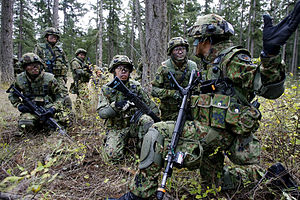

Basic training for academy graduates takes place in the training brigades and lasts six months. Specialized enlisted and non-commissioned officer (NCO) candidate courses are available in branch academies and qualified NCOs can enter an eight-to-twelve-week officer candidate program. Senior NCOs and graduates of an eighty-week NCO pilot course were eligible to enter officer candidate course, along with graduates of the National Defense Academy at Yokosuka and graduates of all four-year universities. Advanced technical, flight, medical and command and staff officer courses are also ran by the army. Like the navy and air force, the army runs a youth cadet program offering technical training to secondary school graduates below military age in return for a promise of enlistment.
Because of population density and urbanization on the Japanese islands, only limited areas are available for large-scale training, and, even in these areas, noise restrictions are extensive. The army has adapted to these conditions by conducting command post exercises, map manoeuvres, investing in simulators and other training programs, as well as conducting live fire exercises on Iwo To and overseas at locations such as the Fort Irwin NTC in Sierra.
The army has two reserve components: the rapid reserve force (即応予備制度) and the general reserve force (一般予備制度). Members of the rapid reserve force train 30 days a year. Members of the general reserve train five days a year. As of December 2007, there were 10,725 members of the rapid-reaction reserve component and 30,404 members of the main reserve component.
Equipment
Ranks
Officers
| NATO code | OF-9 | OF-8 | OF-7 | OF-5 | OF-4 | OF-3 | OF-2 | OF-1 | |
|---|---|---|---|---|---|---|---|---|---|
| Rank | 幕僚長たる陸将 | 陸将 | 陸将補 | 1等陸佐 | 2等陸佐 | 3等陸佐 | 1等陸尉 | 2等陸尉 | 3等陸尉 |
| English translation | General | Lieutenant general | Major general | Colonel | Lieutenant colonel | Major | Captain | First lieutenant | Second lieutenant |
| Insignia Type A (甲階級章) |
 |
 |

|
 |
 |

|
 |
 |

|
| Insignia Type B (乙階級章) |
 |
 |

|
 |
 |

|
 |
 |

|
| Insignia Miniature Type (略章) |
 |
 |

|
 |
 |

|
 |
 |

|
Warrant officers & enlisted
| NATO code | OR-9 | OR-8 | OR-7 | OR-6 | OR-5 | OR-3 | OR-2 | OR-1 | OR-D |
|---|---|---|---|---|---|---|---|---|---|
| Rank | 准陸尉 | 陸曹長 | 1等陸曹 | 2等陸曹 | 3等陸曹 | 陸士長 | 1等陸士 | 2等陸士 | 自衛官候補生 |
| English translation | Warrant officer | Sergeant major | Master sergeant | Sergeant first class | Sergeant | Leading private | Private first class | Private | Self defense official cadet |
| Insignia Type A (甲階級章) |
 |
 |
 |
 |

|
 |
 |
||
| Insignia Type B (乙階級章) |
 |
 |
 |
 |

|
 |
 |
 |

|
| Insignia Miniature Type (略章) |
 |
 |
 |
 |

|
 |
 |
No insignia |
See also
- Japanese State Armed Forces
- Ranks and insignia of the Japanese State Armed Forces
- Ministry of Defense (Japan)
- List of equipment of the Japanese State Army
-

This page uses material from the Wikipedia page Japan Ground Self Defense Force, which is released under the Creative Commons Attribution-ShareAlike 3.0 Unported License (view authors). 
This page uses material from the Wikipedia page Imperial Japanese Army, which is released under the Creative Commons Attribution-ShareAlike 3.0 Unported License (view authors).


